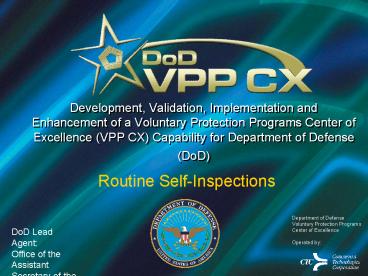Routine SelfInspections PowerPoint PPT Presentation
1 / 23
Title: Routine SelfInspections
1
Development, Validation, Implementation and
Enhancement of a Voluntary Protection Programs
Center of Excellence (VPP CX) Capability for
Department of Defense (DoD)
- Routine Self-Inspections
Department of Defense Voluntary Protection
Programs Center of Excellence Operated by
DoD Lead AgentOffice of the Assistant
Secretary of the Army (Installations and
Environment)
2
Objectives
- After this training you will be able to
- Identify the purpose of self-inspections
- Understand VPP requirements for a written
self-inspection program - Outline self-inspection process and teams
- Define the benefits of self-inspections
- Define the role of Leadership in
self-inspections.
3
Purpose of Self-Inspections
- An effective self-inspection process
- Enhances identification and abatement of worksite
hazards for normal operations - Is essential for an effective safety and health
process.
4
Routine Self-Inspections
- The routine self-inspection system should
- Include written procedures/guidance
- Use qualified personnel to conduct
inspections - Assign responsibility for
abatement/tracking - Result in documentations of findings and
track the hazard elimination or control to
completion.
5
Self-Inspection vs. Hazard Analysis
6
Written Program
7
VPP Requirements
- Written Routine Safety Health (SH)
Self-Inspection Program should include - Inspection schedule
- Make-up and function of self-inspection teams
- How findings/results will be documented
- How employees will have access to the results of
self-inspections - How responsibility and timeframes for abatement
will be assigned - How hazard elimination/control will be tracked to
ensure timely completion - How to use interim control measures if necessary.
8
Access to Inspection Results
- Written plans should state how employees will
have access to self-inspection results - Communicate to employees
- Access to self-inspection results
- Status of corrective actions
- Abatement plans for hazards.
- Update employees at least monthly on inspection
results.
9
Responsibilities/Timeframes for Abatement
- Written plans for responsibilities and timeframes
for abatement should - State how responsibilities and timeframes for
abatement will be assigned - Assign risk factors, severity, probability,
likelihood - Assign responsibility for abatement
- Assign realistic timeframes for abatement.
10
Tracking Hazard Elimination/Control
- Written plans for tracking hazard elimination and
control should - State how hazards identified will
- be tracked either by paper or
- computer system
- Identify process to routinely review
- status of corrective actions
- Identify process to elevate status to
- upper management to resolve issues
- Items gt30 days.
11
Inspection Process
12
Inspection Schedule
- The inspection schedule should
- Contain monthly (or more
- frequent) inspections
- Cover the entire organization (or site) at
least quarterly - Include office/administrative areas
- Include other non-operational areas, such as
recreation, daycare facilities, etc., if covered
by the VPP application.
13
Conducting Inspections
- Some suggestions for conducting various types of
routine self-inspections include - Tiered Area Inspections
- ? Employee inspects own area weekly, monthly,
etc. - ? Supervisor inspects same area quarterly.
- Emergency Equipment Inspections
- ? Employee trained to inspect one or more
fixed emergency equipment such as
emergency eye washes/showers, fire
extinguishers, etc. - Other Equipment Inspections
- ? Employee routinely inspects non-emergency
operational equipment such as ladders,
chains, machine guarding, etc.
14
Self-Inspection Team Members
- Self-inspection team members
- should include
- Non-supervisory employees
- Union representatives
- SH staff
- Managers/supervisors
- Directors/department heads
- Top management.
- Train personnel conducting inspections on hazard
recognition/identification.
15
Documentation of Findings/Results
- Consider the use of checklists to aid in
documenting findings - If used, checklists should be unique to the area
or item being inspected - Clearly identify whether item is Not
Applicable, Conforms, or Doesnt Conform - Write a description of the finding
- Write the location where it was found
- Assign responsibility and timeframe for
abatement.
16
Documentation of Findings / Results
- Develop a checklist using input from both SH
staff and individuals familiar with the area
equipment - Provide space to allow inspector to document
additional findings not included on the
checklist.
17
Use of Inspection Results
- Determine trends to
- Efficiently direct resources
- Prioritize hazard elimination
- Leading vs. Lagging.
- Use results to contribute to the Annual Program
Evaluation - Modify Installation SH goals
- and objectives
- Modify training to increase hazard awareness
- Facilitating meetings with leadership at least
quarterly to discuss/resolve SH
issues/concerns.
18
Benefits
- Systematic approach
- Ongoing
- Tracking and closure.
- Ensure ownership
- Cross Sectional
- All shifts and departments are covered
- Everyone is an inspector, everything
- is inspected.
- Report progress
- Communicate successes
- Drive continuous improvement.
19
Leadership Role
20
Leadership Role
- Actively participate in the inspection process
- Monitor and Measure
- Hold team accountable for conducting
inspections - Hold area leaders accountable for addressing
findings. - Set measurable and attainable goals
- Review inspection results
- Measure proactive results.
21
Leadership Role
- Provide adequate resources
- Time to conduct inspections
- Training for inspection team
- Personal protective equipment.
- Use IT resources to improve process effectiveness
- Inspections produce data
- Capture data in a trend-able form
- Use data to support decision-making.
- Communicate
- Acknowledge successes
- Reward accomplishments.
22
Summary
- In this section you learned about
- The purpose of self-inspections
- VPP requirements for a written self-inspection
program - Self-inspection process and teams
- The benefits of self-inspections
- The role of Leadership in self-inspections.
23
Questions?

